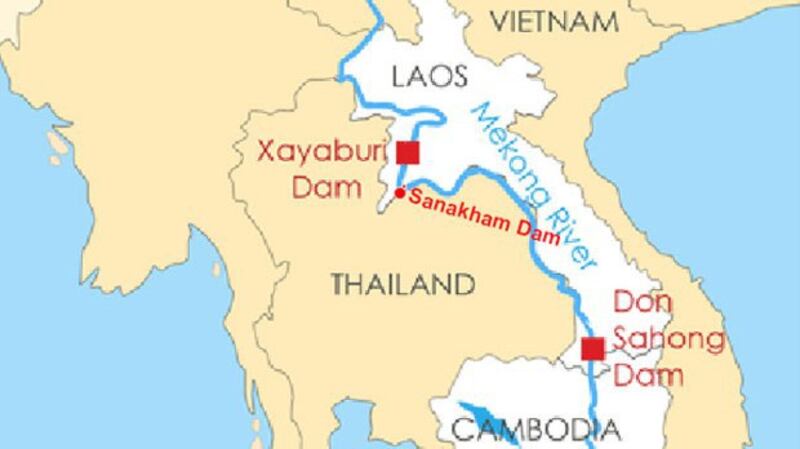Thailand has rejected a new technical report on Laos’ Sanakham dam project, one of nine large-scale Mekong River mainstream dams integral to Vientiane’s controversial economic strategy of becoming the “Battery of Southeast Asia.”
The 684-megawatt Sanakham dam is one of seven future dams in various stages of planning. At a cost of about U.S. $2 billion, it would take eight years to complete once construction starts in Laos’ northwestern Xayaburi province.
Thailand’s Office of National Water Resources told RFA’s Lao Service Tuesday that it does not accept the revisions submitted Jan. 15 to the Thai National Mekong River Committee by the Chinese dam developer, Datang Corporation Limited.
“Both our office and the Mekong committee concluded that the information in the new report is still not sufficient. More study is required,” said Somkiat Prajamwong, the office’s secretary general.
Somkiat Prajamwong said the new report did not include data on the impact on the environment or how it would affect people who live below the proposed dam. He called on the developer to conduct an extensive environmental impact assessment and again revise the report before the next prior consultation.
RFA contacted the Lao Ministry of Energy and Mines but nobody there would answer questions about the Sanakham dam project.
However, the ministry told Thai media in December that it would comply with all requirements to get the project started and it was waiting for comments from other members of the Mekong River Commission (MRC), an intergovernmental agency that works with the governments of Laos, Vietnam, Thailand and Cambodia, to manage the 2,703-mile river’s resources.
The Sanakham dam is slated to be built on Mekong River North of Veunkham Village, in Xayaburi’s Kenthao district. The project is expected to displace 3,000 residents of 13 villages.
Residents living close to the proposed construction site told RFA that they were worried that they might be forced to relocate, and they were concerned that the dam would harm local fish stocks.
“The dam will have a serious impact on the fish population, and we don’t know how we’re going to be compensated,” a resident of Kenthao told RFA under condition of anonymity.
Another resident of the district expressed concerns about the property his home and farm sit on, saying, “We don’t know where we’ll have to move to, nor do we know how we’ll be compensated. The dam developer has been here, and they did some surveys and collected information.”

Inspections planned
Laos plans to conduct safety inspections of 79 existing dams on the Mekong and its tributaries.
“We’re planning to inspect the dams before and after the rainy season once every five years,” an official from Ministry of Energy and Mines’ Energy Management Department told RFA Thursday.
“If defects are found, the dam developers have to make the necessary repairs. Then the repaired dam must be passed the ministry’s inspection again,” the official said.
According to the official, the ministry has inspected 55 dams since 2019, finding that 10 smaller dams were not built to official standards. The ministry also conducted safety drills and tested the emergency warning systems of some of these dams.
The series of inspections included the Xe Pian-Xe Namnoi dam, which collapsed in July 2018, causing a disaster that has been described as Laos’ worst flooding in decades.
Surging water and mud killed 71 people and wiped out all or part of 19 villages, sweeping away homes and causing severe flooding in villages downstream in Attapeu province and beyond into Cambodia.
The National Investigation Committee in May 2019 held a press conference to explain the cause of the dam’s collapse, saying that the main culprits were the high absorbency of the saddle dam’s foundation, and the surrounding porous and easily eroded soil.
Besides the dozens of hydropower dams on the Mekong and its tributaries, Laos has plans to build scores more in hopes of exporting the electricity they generate to other countries in the region.
Though the Lao government sees power generation as a way to boost the country’s economy, the projects are controversial because of their environmental impact, displacement of villagers without adequate compensation, and questionable financial and power demand arrangements.
Reported by RFA’s Lao Service. Translated by Max Avary. Written in English by Eugene Whong.
